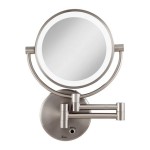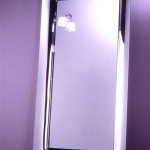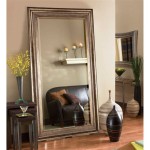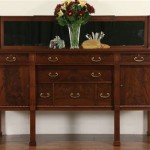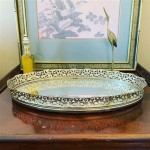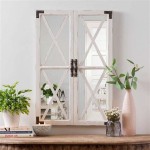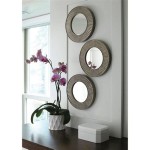How To Hang A Large Frameless Mirror Without Clips
Hanging a large, frameless mirror presents unique challenges. The absence of a traditional frame removes the usual mounting points, demanding alternative methods for secure and aesthetically pleasing installation. This article outlines several effective techniques for hanging a large frameless mirror without using clips, ensuring a safe and stylish addition to any space.
1. Adhesive Mirror Mounting Tape
Adhesive mirror mounting tape is a popular choice for hanging frameless mirrors due to its ease of use and strong bonding capabilities. This double-sided tape is specifically designed to adhere to both glass and wall surfaces, providing a secure hold for heavy mirrors. Before application, thoroughly clean both the wall and the back of the mirror with isopropyl alcohol to remove any dust, grease, or residue that could compromise the adhesive's strength.
Measure and mark the desired mirror placement on the wall using a level and pencil. Cut the adhesive tape into vertical strips and apply them to the back of the mirror, following the manufacturer's instructions for spacing and placement. These strips should be evenly distributed across the back surface, ensuring weight distribution is balanced. Carefully peel off the backing paper from the tape and position the mirror onto the marked area on the wall. Apply firm, even pressure across the mirror's surface to ensure a secure bond.
While mounting tape offers a convenient solution, it's crucial to choose a high-quality product specifically designed for mirrors and to follow the weight limitations provided by the manufacturer. For extremely large or heavy mirrors, additional support methods might be necessary.
2. J-Channels
J-channels provide a more robust and secure mounting method for heavy frameless mirrors. These aluminum or plastic channels are shaped like a "J," with one side designed to be attached to the wall and the other to receive the edge of the mirror. This method offers excellent support and allows for minor adjustments during installation.
Begin by accurately measuring the dimensions of the mirror and cutting the J-channels accordingly. Using appropriate wall anchors and screws, secure the bottom J-channel to the wall at the desired height, ensuring it is perfectly level. Then, carefully insert the bottom edge of the mirror into the channel. Install the side J-channels next, ensuring they fit snugly against the mirror's edges and are securely fastened to the wall. Finally, install the top J-channel, completing the enclosure and securing the mirror in place.
J-channels offer adjustable positioning and strong support, making them a suitable choice for larger, heavier frameless mirrors. They also provide a clean, finished look, concealing the mounting hardware.
3. Mirror Mastic
Mirror mastic is a specialized adhesive formulated to bond mirrors to various substrates. It offers exceptional holding strength and is often preferred for larger, heavier mirrors where other methods might be insufficient. Mirror mastic requires a longer curing time compared to mounting tape but provides a more permanent and robust bond.
Before applying mastic, ensure the wall surface is clean, dry, and free of any debris. Apply the mastic in vertical beads to the back of the mirror, following the manufacturer's instructions for spacing and bead size. These beads should be evenly distributed across the mirror's surface to ensure even weight distribution and prevent undue stress on the glass. Carefully position the mirror onto the designated wall area and apply even pressure. Temporary supports, such as wooden blocks or braces, might be necessary to hold the mirror in place while the mastic cures. Follow the manufacturer’s instructions regarding the required curing time before removing these supports.
Mirror mastic offers a strong and permanent bond, making it a suitable option for large, heavy frameless mirrors. However, it is important to exercise caution during installation as repositioning the mirror after the mastic has begun to set can be challenging.
4. French Cleats
French cleats provide a robust and versatile hanging solution, especially for heavy objects like large frameless mirrors. A French cleat system consists of two interlocking pieces of wood, one attached to the wall and the other to the back of the mirror. The angled design of the cleats creates a strong, downward-facing force, securely holding the mirror in place.
Begin by selecting a French cleat system with a weight capacity appropriate for the mirror. Attach one part of the cleat system to the wall using appropriate anchors and screws, ensuring it is level. Attach the corresponding cleat to the back of the mirror, ensuring proper alignment with the wall cleat. Carefully lift the mirror and engage the two cleats, ensuring they interlock securely. This method offers excellent weight distribution and a secure hold, even for heavy mirrors.
French cleats provide a hidden mounting solution, creating a clean, floating appearance. This method is particularly well-suited for applications where a minimalist aesthetic is desired.

How To Install A Mirror Without Frame Merrypad

How To Install A Mirror Without Frame Merrypad

How To Hang A Frameless Mirror On The Wall With Pictures

How To Hang A Frameless Mirror On The Wall With Pictures

How To Hang A Frameless Mirror On The Wall With Pictures

Mirror Installation Without Clips

How To Hang A Hanging Mirror Without Accompanying Hardware
:strip_icc()/DesireeBurnsInteriors1-f76d25cad90041c88fbae4a7dc10aab4.jpg?strip=all)
2 Simple Ways To Hang A Frameless Mirror

How To Hang A Frameless Mirror June 2024 Your Guide Hanging

How To Hang A Frameless Mirror On Wall E Architect

